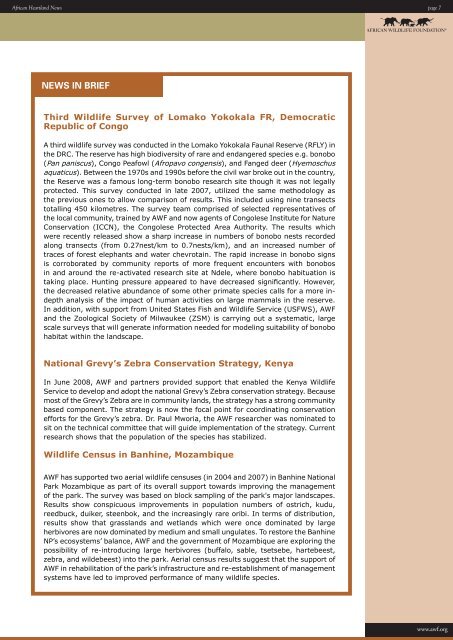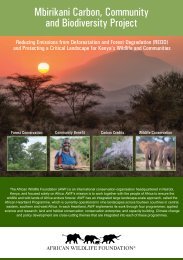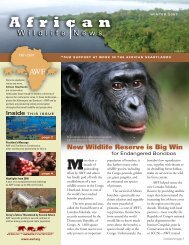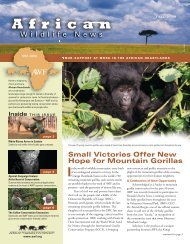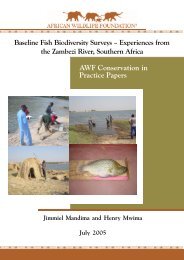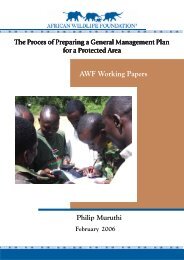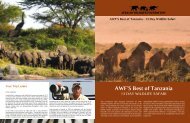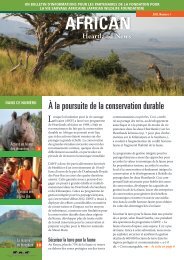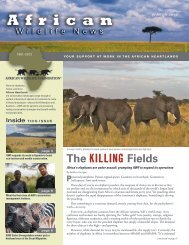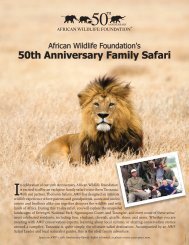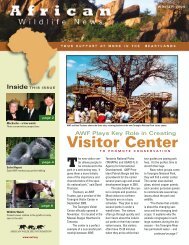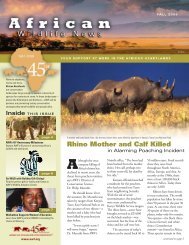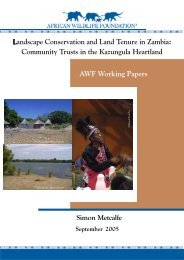Download - African Wildlife Foundation
Download - African Wildlife Foundation
Download - African Wildlife Foundation
You also want an ePaper? Increase the reach of your titles
YUMPU automatically turns print PDFs into web optimized ePapers that Google loves.
<strong>African</strong> Heartland News page 7<br />
<br />
Third <strong>Wildlife</strong> Survey of Lomako Yokokala FR, Democratic<br />
Republic of Congo<br />
A third wildlife survey was conducted in the Lomako Yokokala Faunal Reserve (RFLY) in<br />
the DRC. The reserve has high biodiversity of rare and endangered species e.g. bonobo<br />
(Pan paniscus), Congo Peafowl (Afropavo congensis), and Fanged deer (Hyemoschus<br />
aquaticus). Between the 1970s and 1990s before the civil war broke out in the country,<br />
the Reserve was a famous long-term bonobo research site though it was not legally<br />
protected. This survey conducted in late 2007, utilized the same methodology as<br />
the previous ones to allow comparison of results. This included using nine transects<br />
totalling 450 kilometres. The survey team comprised of selected representatives of<br />
the local community, trained by AWF and now agents of Congolese Institute for Nature<br />
Conservation (ICCN), the Congolese Protected Area Authority. The results which<br />
were recently released show a sharp increase in numbers of bonobo nests recorded<br />
along transects (from 0.27nest/km to 0.7nests/km), and an increased number of<br />
traces of forest elephants and water chevrotain. The rapid increase in bonobo signs<br />
is corroborated by community reports of more frequent encounters with bonobos<br />
in and around the re-activated research site at Ndele, where bonobo habituation is<br />
taking place. Hunting pressure appeared to have decreased significantly. However,<br />
the decreased relative abundance of some other primate species calls for a more indepth<br />
analysis of the impact of human activities on large mammals in the reserve.<br />
In addition, with support from United States Fish and <strong>Wildlife</strong> Service (USFWS), AWF<br />
and the Zoological Society of Milwaukee (ZSM) is carrying out a systematic, large<br />
scale surveys that will generate information needed for modeling suitability of bonobo<br />
habitat within the landscape.<br />
National Grevy’s Zebra Conservation Strategy, Kenya<br />
In June 2008, AWF and partners provided support that enabled the Kenya <strong>Wildlife</strong><br />
Service to develop and adopt the national Grevy’s Zebra conservation strategy. Because<br />
most of the Grevy’s Zebra are in community lands, the strategy has a strong community<br />
based component. The strategy is now the focal point for coordinating conservation<br />
efforts for the Grevy’s zebra. Dr. Paul Mworia, the AWF researcher was nominated to<br />
sit on the technical committee that will guide implementation of the strategy. Current<br />
research shows that the population of the species has stabilized.<br />
<strong>Wildlife</strong> Census in Banhine, Mozambique<br />
AWF has supported two aerial wildlife censuses (in 2004 and 2007) in Banhine National<br />
Park Mozambique as part of its overall support towards improving the management<br />
of the park. The survey was based on block sampling of the park's major landscapes.<br />
Results show conspicuous improvements in population numbers of ostrich, kudu,<br />
reedbuck, duiker, steenbok, and the increasingly rare oribi. In terms of distribution,<br />
results show that grasslands and wetlands which were once dominated by large<br />
herbivores are now dominated by medium and small ungulates. To restore the Banhine<br />
NP’s ecosystems’ balance, AWF and the government of Mozambique are exploring the<br />
possibility of re-introducing large herbivores (buffalo, sable, tsetsebe, hartebeest,<br />
zebra, and wildebeest) into the park. Aerial census results suggest that the support of<br />
AWF in rehabilitation of the park’s infrastructure and re-establishment of management<br />
systems have led to improved performance of many wildlife species.<br />
www.awf.org


